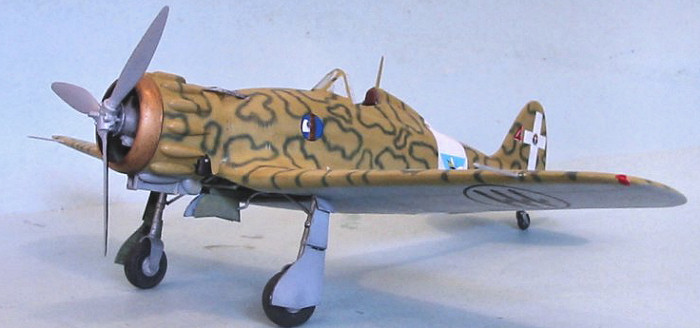
| KIT: | Pacific Coast Hobbies 1/32 Macchi C.200 |
| KIT #: | 32001 |
| PRICE: | $49.95 |
| DECALS: | Six options |
| REVIEWER: | Tom Cleaver |
| NOTES: | Multimedia kit with resin and p.e. parts |

| HISTORY |
During the Second World War, Italian aircraft were subjected to distorted propaganda that played on the fact the Italians were using aircraft that did not look as aerodynamically advanced as did the aircraft being used by the Allies. The Italian air industry was hobbled by older production techniques, and by the
need to meet design specifications issued by an overly‑ conservative Regia Aeronautica, and to cater to the extreme conservatism of Italian combat pilots when it came to such questions as the supremacy of the monoplane over the biplane, the need for enclosed cockpits, the need for a heavy armament, and other things considered de rigeur in the aeronautical state of the art. It didn't help that the Italian aircraft industry had nothing like the Merlin or Daimler‑Benz series of in‑line engines, or the high‑powered radials created by Pratt & Whitney.
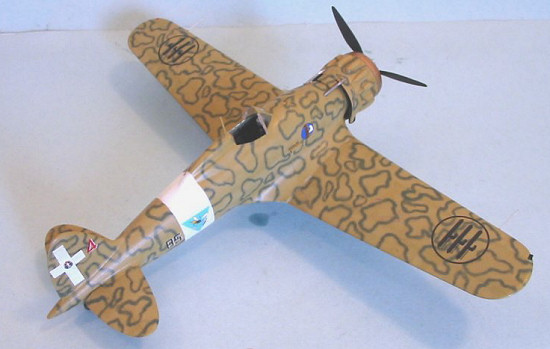 That said, just about
everything anyone "knows" about Italian aircraft from reading non‑Italian
sources is false, due to the "hang‑over" created by Second World War propaganda.
That said, just about
everything anyone "knows" about Italian aircraft from reading non‑Italian
sources is false, due to the "hang‑over" created by Second World War propaganda.
A prime example of this is the Macchi‑Castoldi series of fighters, and particularly the progenitor of the series, the C.200 Saetta (which can be translated as both Lightning Bolt or Arrow ‑ the weapons of Jupiter).
The Castoldi fighters had a similar background and pedigree to that of Reginald J. Mitchell's Spitfire, since Mario Castoldi was his sharpest competitor in the creation of high speed seaplanes for the Schneider Cup Trophy competition that lasted from1920 to 1931. Castoldi's racers had been top competitors, with the M.39 winning the 1926 Schneider competition, and the M.C.72 going on in 1933 to beat the record of the Supermarine S.6B by setting a world air speed record of 423.82 m.p.h. Unfortunately, the problems in engine development that had kept the M.C.72 from beating the S.6B to win the Schneider Cup outright would also dog the development of Castoldi's fighters.
The Schneider influence on the C.200 was not so apparent upon its rollout, since the best engine the Italians had available was the Fiat A.74 R.C.38, a magnificent powerplant derived from Gnome‑Rhone designs, but capable of only 870 h.p. Another stumbling block was the insistence of the Air Force that the best possible field of view for the pilot was paramount before aerodynamic cleanliness. The result was an airplane with a bulky, drag‑producing radial in a poorly‑designed cowling, matched to a humped‑back fuselage that completely eradicated all evidence of the fighter's racer lineage.
Flight trials following first flight on December 24, 1937, revealed the C.200
was singularly maneuverable, with exceptionally well‑harmonized controls and no
vices. One remarkable bit of aerodynamic sleight of hand was the asymmetric
wing, in which the left wing was longer than the right, which effectively
canceled engine torque and added to the airplane's maneuverability. Like all
other Italian fighters, it was lightly armed in comparison with its
contemporaries, carrying only two .50 caliber machine guns
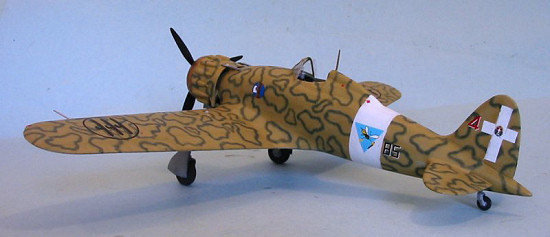 with 370 rounds per gun.
with 370 rounds per gun.
The conservative pilots of the Italian fighter arm disliked the enclosed cockpit's sliding canopy. The C.R.42‑equipped 4 Stormo refused to take the first C.200s because the monoplane ‑as maneuverable as it was ‑ was less so than their biplanes. The pilots of 1 Stormo, who had flown the C.R.32 in the Spanish Civil War, were most anxious to convert to the C.200 since their experiences over Spain had convinced them the day of the biplane was over.
The C.200 did not see combat until June 1940, when the aircraft of the 6 Gruppo Autonomo in Sicily were assigned to provide escort to S.79 Sparvieros bombing Malta. When faced by the Hawker Hurricane, both had similar performance, though the C.200 had a considerably better climb rate and could out‑turn and out‑dive the British fighter, as well as having an equal ability to absorb punishment. In March 1941,Saettas of the 150 Gruppo entered combat over Greece while the C.200s of the 374 Squadriglia arrived in Libya, followed shortly by the similarly‑ equipped 153 Gruppo. That summer, the Corpo di Spedizio Italiano was formed for operations in the Soviet Union, with a fighter element equipped with 59 Saettas of the 22 Gruppo.
While Allied propaganda made fun of the way the C.200 looked, Allied fighter pilots found it a worthy opponent in the hands of a skilled pilot, and accorded it respect. A standard C.200 weighing 5,121 pounds, attained a maximum speed of 312 mph at 14,759 ft., while an altitude of 3,280 ft. was attained in 1 minute, 3 seconds, a very creditable climb performance. Service ceiling was 29,200 feet, and normal range was 354 miles.
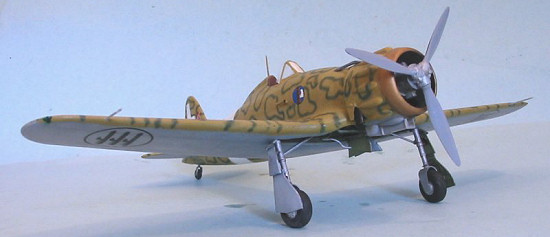 By 1941, the C.202, powered
by a German Daimler‑Benz D.B.601 engine with an appreciably higher performance
that allowed Mario Castoldi to restore the symmetry of line associated with his
racers began rolling off the production line. Sharing 80
By 1941, the C.202, powered
by a German Daimler‑Benz D.B.601 engine with an appreciably higher performance
that allowed Mario Castoldi to restore the symmetry of line associated with his
racers began rolling off the production line. Sharing 80
percent commonality with the earlier C.200, the two fighters were produced simultaneously through 1942, due to a lack of engines for the C.202, with the C.200 assuming tactical duties as a fighter bomber and ground strafer while the C.202 undertook the air superiority mission.
C.200s were among the Italian fighters that joined the Co‑Belligerent Air Force after the Italian surrender in September1943, and the airplane served to the end of the war.
| THE KIT |
This
kit from Ken Lawrence's Pacific Coast Models is a testament to the fact that
"anybody who knows me knows you don't tell me 'you can't do that,'" as Ken
explains. PCM is the leading distributor of quality resin and multi‑media kits
of Italian aircraft, and the C.200 had long been one of Ken's favorites. In
1/48, the C.200 was the first 1/48 kit released by PCM, as it is here in 1/32.
With 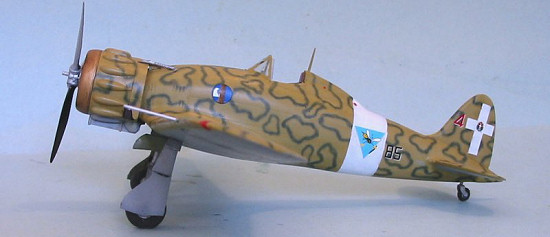 the 1/48 kit, Ken went to
Italian aircraft expert Maurizio de Terlizzi and got a kit designed that he could
have produced by MPM under contract, with resin detail parts by another Italian
company and decals printed by Cartograph, with photo‑etch detail parts by Eduard.
"The deal was, Massimo had to approve the final design of the kit, and until he
was satisfied it wasn't ready to go into production." The same process was
applied to this 1/32 kit.
the 1/48 kit, Ken went to
Italian aircraft expert Maurizio de Terlizzi and got a kit designed that he could
have produced by MPM under contract, with resin detail parts by another Italian
company and decals printed by Cartograph, with photo‑etch detail parts by Eduard.
"The deal was, Massimo had to approve the final design of the kit, and until he
was satisfied it wasn't ready to go into production." The same process was
applied to this 1/32 kit.
The injection‑molded parts for the airframe are by MPM and are among the best work they have done on any kit to date. The resin detail for the cockpit and engine is superb, but what really blows things away is the fully‑hollow single‑casting of the cowling with all its bulges and shape changes. It is thin, and perfectly cast, looking better than any other attempt by any other model company to get the most obvious component of the C.200 "right." The vacuform canopy allows the modeler to create that version of the Saetta with the folding side flaps, though one can also cut them off to make other production versions.
The decals are beautiful, providing two different versions of the fasces national insignia, and all other markings for six different C.200s in the four different camouflage patterns used on the airplane.
| CONSTRUCTION |
 This kit is as close to a Tamigawa "slammer" as a limited‑run kit gets. The
parts are mostly flash free and easily cleaned up. It's important to cut off
the mold‑release pins on the interior surfaces of the wings and fuselage and
horizontal stabilizers, but there is no difficulty with that.
This kit is as close to a Tamigawa "slammer" as a limited‑run kit gets. The
parts are mostly flash free and easily cleaned up. It's important to cut off
the mold‑release pins on the interior surfaces of the wings and fuselage and
horizontal stabilizers, but there is no difficulty with that.
 Having
learned my lesson with the first of these kits I built last year, I first
painted and assembled the cockpit, then installed it in the fuselage half. I
also assembled the engine mount and the fuselage bulkhead/wing spar. Doing it
this way, I was able to take some stretched sprue and put it in to represent the
engine wiring one can see through the wheel well. I then assembled the fuselage
halves. I attached the lower wing to the fuselage and got it positioned
correctly, then attached the upper wing surfaces. Things
Having
learned my lesson with the first of these kits I built last year, I first
painted and assembled the cockpit, then installed it in the fuselage half. I
also assembled the engine mount and the fuselage bulkhead/wing spar. Doing it
this way, I was able to take some stretched sprue and put it in to represent the
engine wiring one can see through the wheel well. I then assembled the fuselage
halves. I attached the lower wing to the fuselage and got it positioned
correctly, then attached the upper wing surfaces. Things
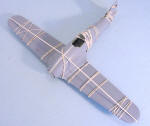 went
together much more easily this way than attempting to put together two sub
assemblies of fuselage and wing as I had done before.
went
together much more easily this way than attempting to put together two sub
assemblies of fuselage and wing as I had done before.
Overall I only needed Mr. Surfacer 500 on the fuselage centerline sea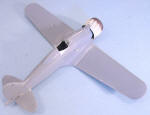 m
and the wing‑fuselage joints. These seams and joints disappeared under a coat of
Mr. Surfacer accompanied with a few minutes of sanding once it had dried.
m
and the wing‑fuselage joints. These seams and joints disappeared under a coat of
Mr. Surfacer accompanied with a few minutes of sanding once it had dried.
I assembled the engine after painting the component parts with various shades of Metalizer paints. The engine has separate cylinders, but is again well‑designed and goes together without problem.
I cut the cowling off its molding block, and slipped the engine inside. The engine and cowling attached to the rest of the model without difficulty.
| COLORS & MARKINGS |
Painting:
This time I did not do any pre-shading. First, I painted the areas of the fuselage stripe and the cross on the vertical fin with Tamiya Flat White, then masked that off with Tamiya tape. I also painted the exhaust collector ring on the cowling with Gunze-Sangyo Mr. Color “Brass,” after which I gave it a coat of Tamiya “Smoke” to pop out the detail, and masked that off with Tamiya tape.
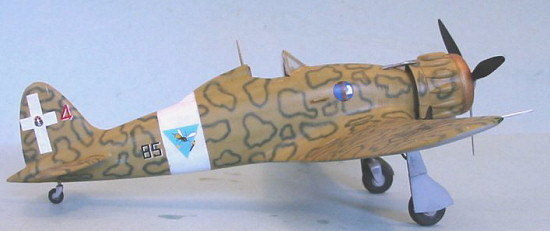 The lower surface was
painted with Xtracrylix “Dark Compass Grey,” then I added in some “Light Compass
Grey” and went over the various panels to post-shade the scheme. Since I was
doing a Breda-built C.200, I applied this lower color to the lower surface of
the fuselage and the cowling.
The lower surface was
painted with Xtracrylix “Dark Compass Grey,” then I added in some “Light Compass
Grey” and went over the various panels to post-shade the scheme. Since I was
doing a Breda-built C.200, I applied this lower color to the lower surface of
the fuselage and the cowling.
The upper surface was painted with Xtracrylix British “Middle Stone,” to which I then applied some Xtracrylix “U.S. Gulf War Armor” tan, and went over the panels. I applied a bit more of the lighter color and re-did this on the upper surfaces of the wings and horizontal stabilizer and upper part of the fuselage, to simulate sun fading of the paint.
The
last part of the painting was the “smoke rings,” which were done with Xtracrylix
“U.S. Medium Green.” Lots of modelers don’t seem to understand that these were
not nice, neat examples of spray painting, and opt for decals to make the model
look nice and neat. In fact, photographs show the “smoke rings” were messy with
overspray, and that no two airplanes done with this scheme were alike, since the
application of the pattern was entirely at the discretion of the individual
painter. I thinned the paint 50-50 with Xtracrylix Thinner and applied various
size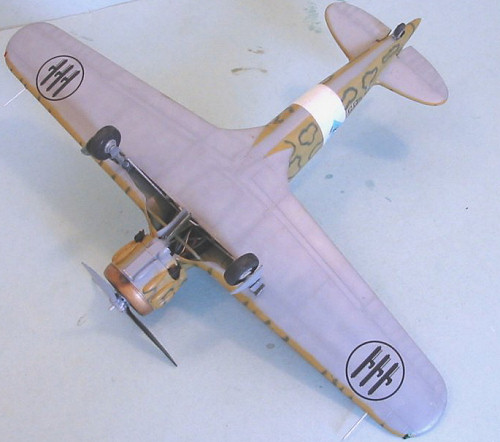 s and shapes of “smoke
rings,” not worrying about neatness and uniformity.
s and shapes of “smoke
rings,” not worrying about neatness and uniformity.
I finished off with a coat of Xtracryli
Decals:
I chose to do the C.200 flown by Teniente Giuseppe Re of the 85th Squadriglia, 18th Gruppo of 3rd Stormo, based at Abu Haggag in Libya at the time of the Battle of El Alamein. The Cartograph decals went down without any problem under a coat of Micro-Sol.
| FINAL CONSTRUCTION |
After washing off decal setting solution residue, the model received a coat of Xtracrylix Satin Varnish, followed by two coats of Xtracrylix Flat Varnish. I then assembled the landing gear and attached the prop.
| CONCLUSIONS |
While I call the C.200 "funky‑looking but cool," several friends swear it is "downright ugly." Whichever. The C.200 was an important part of the Regia Aeronautica during World War II, and as such is deserving of a place in any collection of significant Italian aircraft of that conflict. I look forward to adding the coming C.202 and C.205 kits to my 1/32 Macchi collection.
April 2006
Kit Courtesy Ken Lawrence at Pacific Coast Models. Order yours at http://www.pacmodels.com/
If you would like your product reviewed fairly and quickly by a site that has over 300,000 visitors a month, please contact me or see other details in the Note to Contributors.